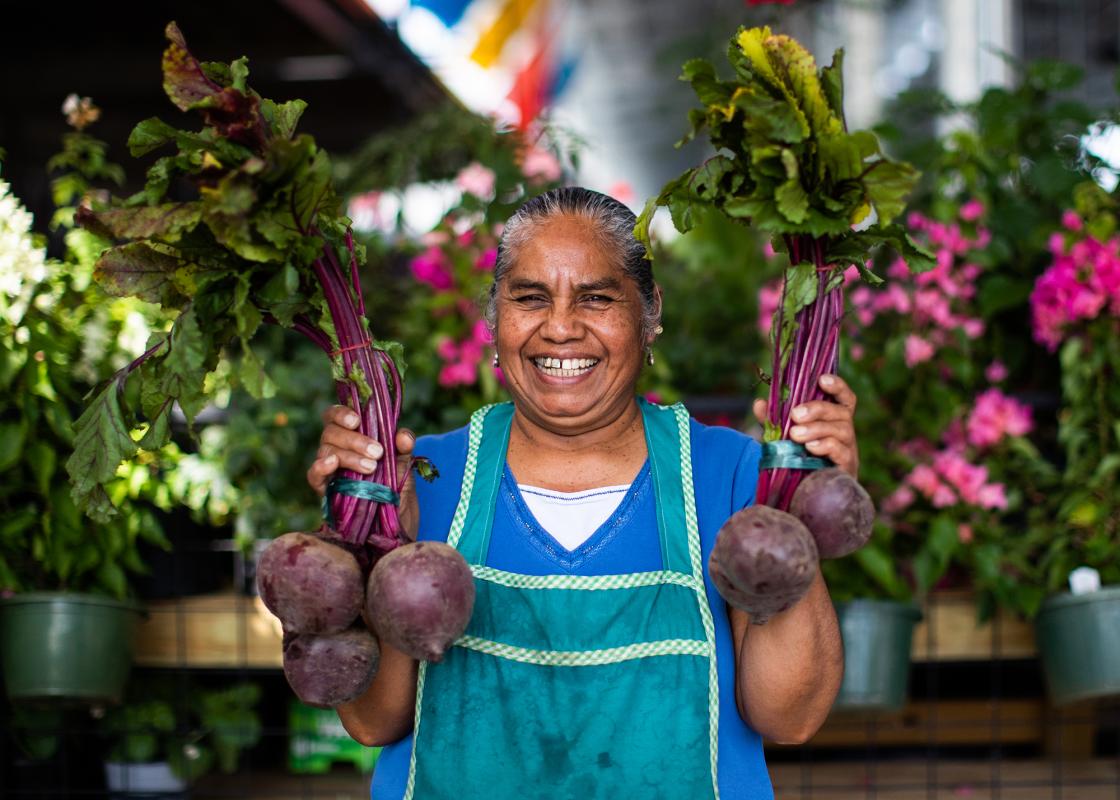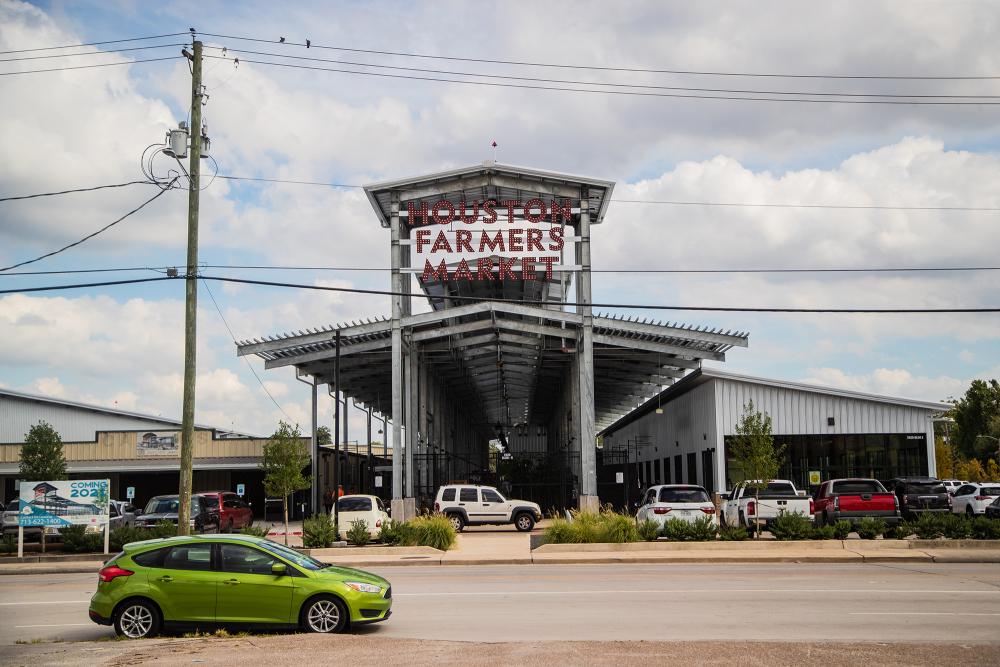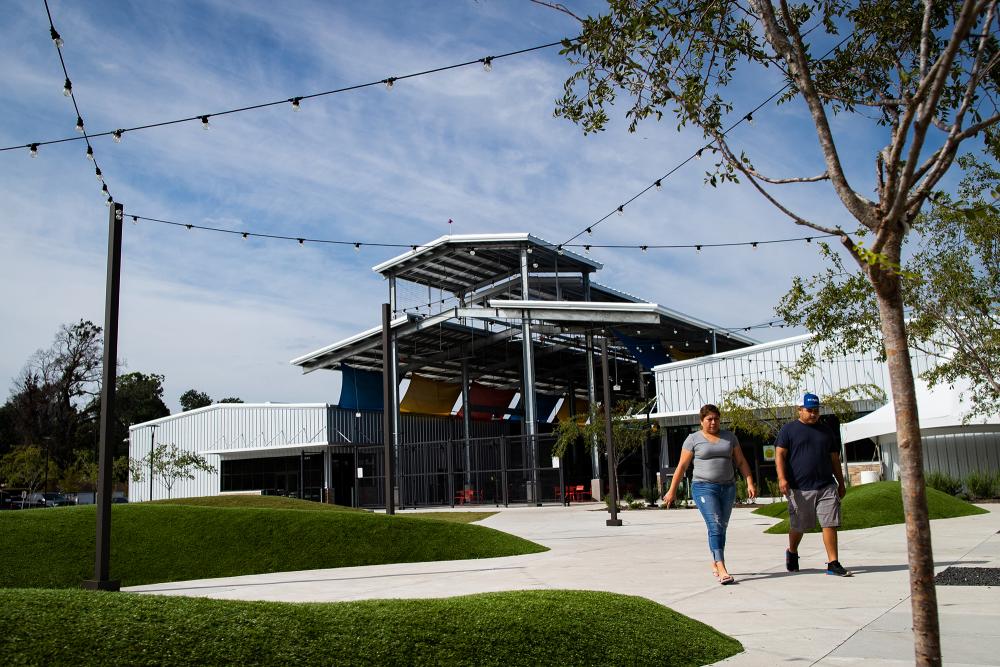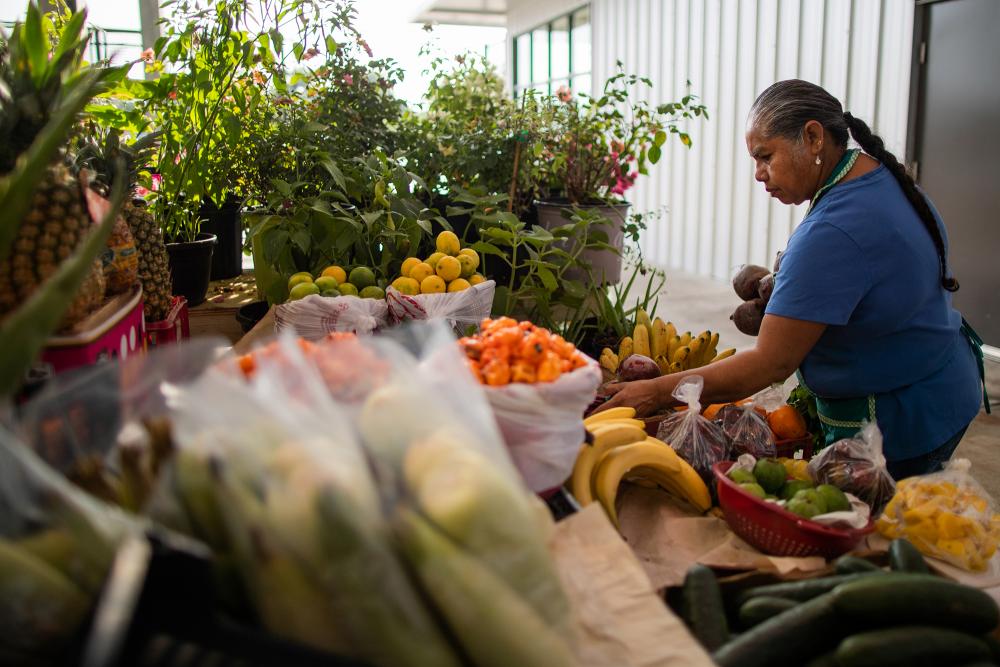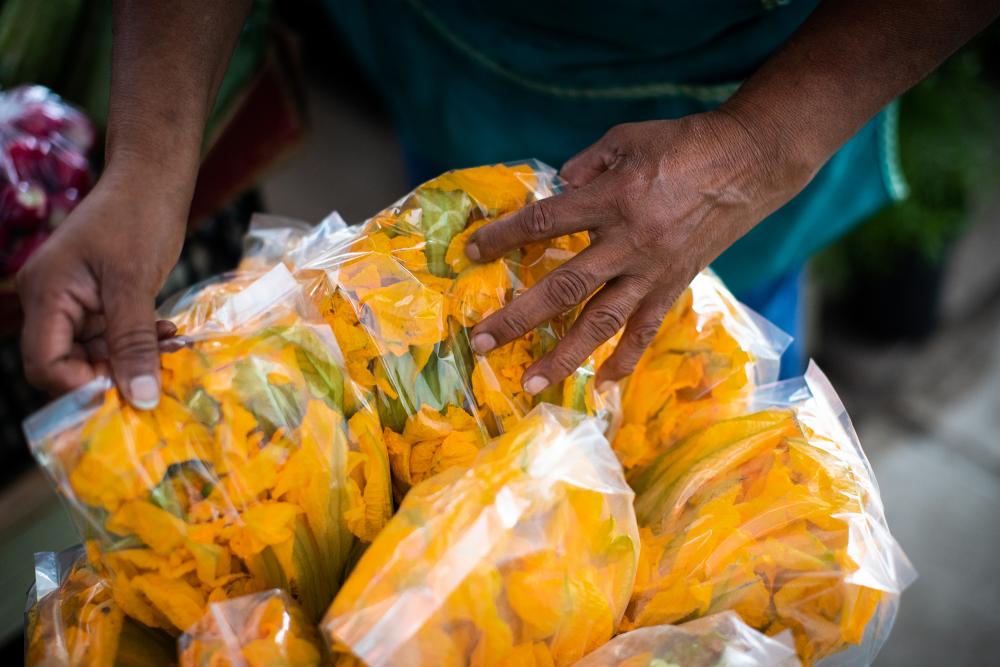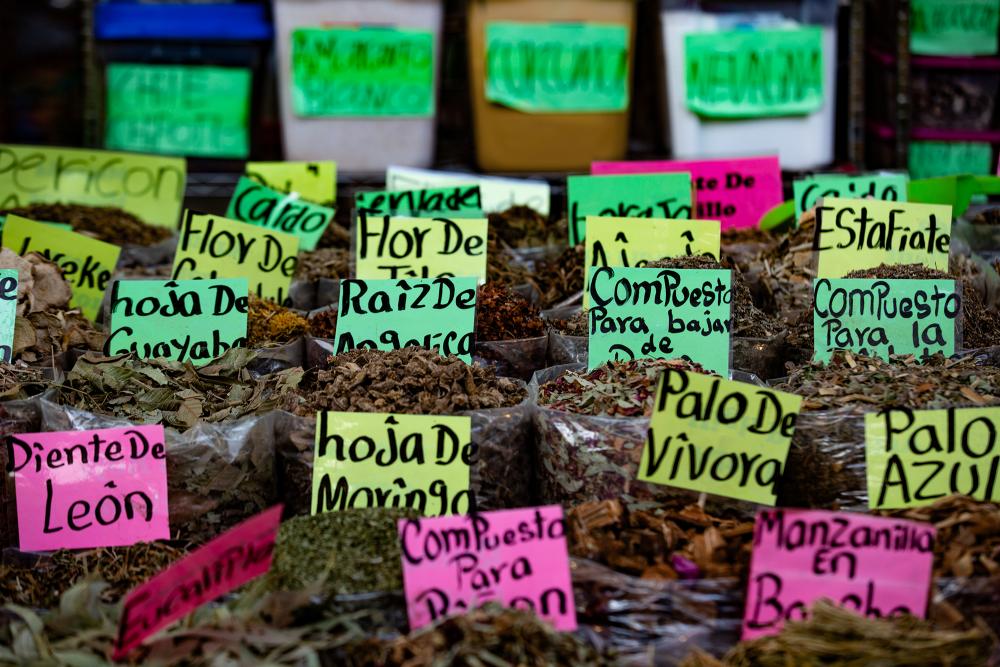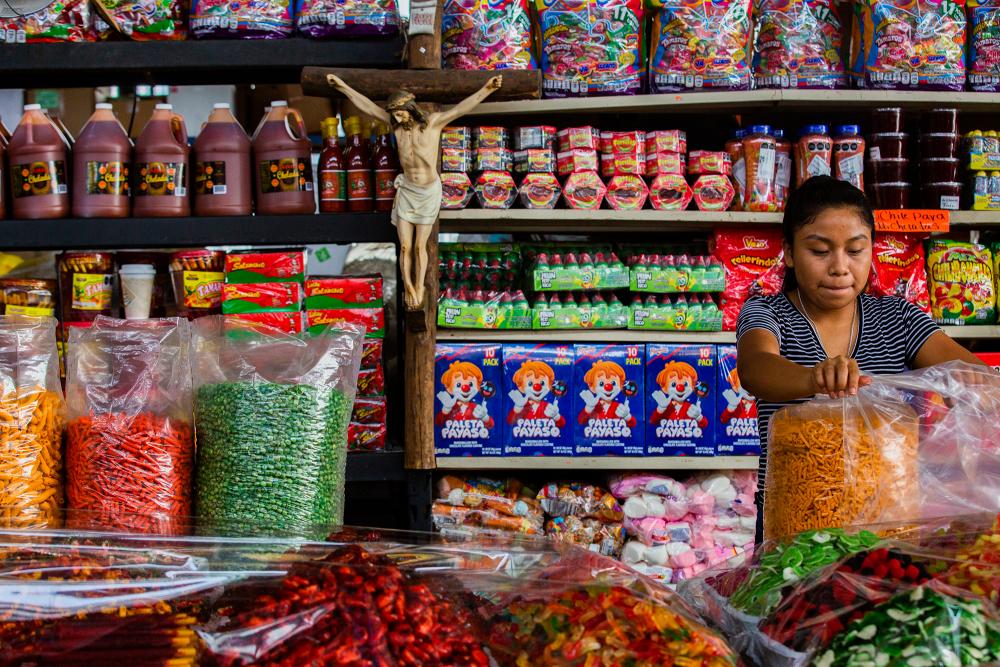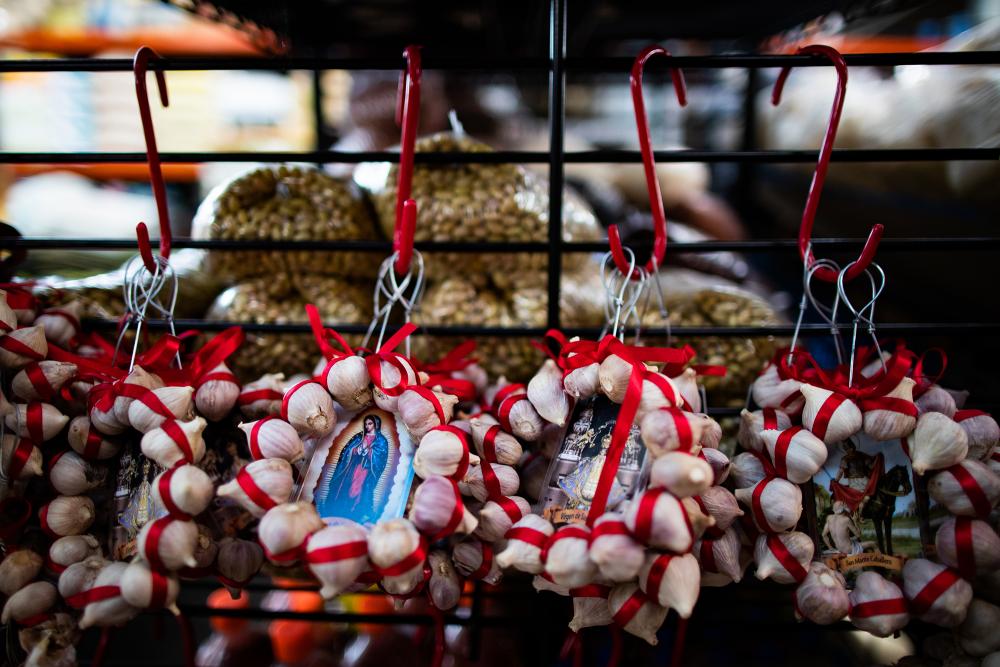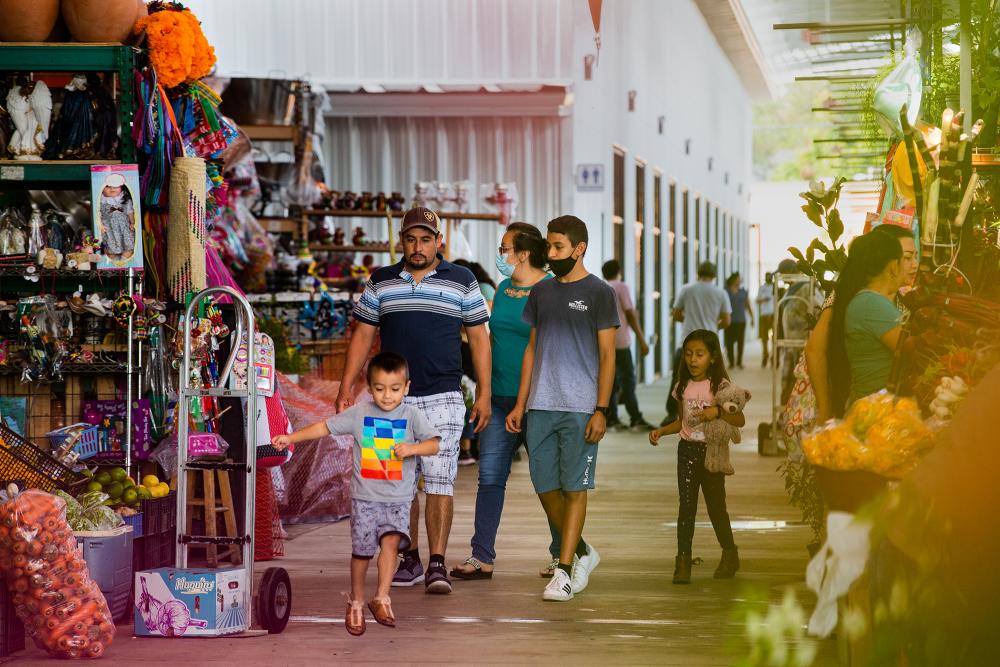Houston occupies the land of ancient civilizations. The Atakapa, Akokisa, Deadose, and the better-known Karankawa lived their days here with family and friends, as we do today. As far back as 13,000 years ago, they traded goods with people in Mexico City and Central America. Today, the Houston Farmers Market embodies the culinary commerce of Texas’s Indigenous peoples and its inherent social relationships. The market, expanded by recent renovations, has become a social space of memory, identity, and community. It remains a go-to source for ingredients essential to Mexican and Latin American cuisines.
Lupita Pereira surveys the arrangement of vegetables, fruits, and herbs that she sells in her 40 ’× 20’ open-air stand at the Houston Farmers Market located at 2520 Airline Drive, 4.5 miles north of downtown. After being rummaged by a customer, a small wooden crate catches her eye; she steps toward it to straighten the rows of nopalitos (cactus paddles), noticeably bright green because they were picked while young and tender. Alongside is another crate filled with the fruit that sprouts from the cactus paddles when they are mature, a magenta, pear-shaped fruit called tuna. Her crates are never without the staple that's always in demand: tatuma, a native heirloom squash called calabacita in Spanish. And, of course, always, there is maíz, corn.
Pereira specializes in the ingredients that are essential for cooking the traditional flavors of Mexican and Latin American cuisines. Given Houston’s current demographics, these are the aromas that waft through 45% of the city’s kitchens. Some of the ingredients that she stocks are not available at grocery stores like H-E-B, Randalls, or Kroger; sometimes they’re not even in the grocers that cater to Latinx neighborhoods. Shoppers crowd the market for canela, the special Mexican cinnamon originally from Sri Lanka, as its taste is more delicate and complex than the regular cinnamon found in most groceries. Customers can also find the tiny chile piquin, native to Texas, and guaje, the delicious seed pods of a tree for which the Mexican state of Oaxaca is named: huaxyacac, in Nahuatl.
"Este es pápalo," says Pereira, pointing to a bouquet of leafy stems arranged in a red plastic bucket of water. “This is pápalo.” Its leaves are eaten raw, freshly pinched off the stem and popped onto tacos, tortas, soups, and salads. At first only the cognoscenti recognized and appreciated the distinctive vegetal taste and potent aroma of the Mexican green, although now it appears in recipes of celebrities like Martha Stewart, Alice Waters, and on the Food Network.
Pereira has steadily grown her business in the ten years since she started her stand. Now she manages a staff of eight vendors, each with different shifts and staggered days off, as she is open for business every day of the year except Christmas and New Year's Day. During the last three years she and her staff have tolerated constant dust and noise: in order to make improvements and add capacity, the market has been busy with construction workers, large machinery, and scaffolding.
The change is the result of new leadership. In 2017, the market was sold to MLB Capital Partners, a Houston-based private investment company that specializes in commercial real estate, development, and hospitality investments. Beginning in 2019 and finishing in 2021, the 18-acre property underwent a $10 million redevelopment that included the renovation of existing open-air pavilions, the construction of a new pavilion and buildings with air-conditioned spaces, new landscaping, and the repaving of the parking lot. The design effort was led by Studio Red Architects.
Pereira is glad that most of the construction is complete. There are brand new bathrooms and more parking for her customers. She likes the improvements, exclaiming, "Bendecido!" "Blessed!" The owner of Pereira's Produce—as she privately and proudly calls her business—knows that change is in the air, as the market continues its transformation.
About fifty yards down from Pereira, under the newly built, forty-foot-tall central shade structure, Inocencia Barrera bustles among bunches of herbs, beets, bananas, and fruits displayed on aboveground shelves and crates. Because she works alone, she is constantly working, tending to the produce in her 20’ × 20’ stall. She's not had good luck recently with hiring people to help her. "No quieren trabajar." "They don't want to work," she says.
With an easy and natural broad smile, Barrera has been a produce business owner in this market for thirty-eight years. In the 1980s the market initially offered Mexican American and Mexican produce, but over time has begun to include Central American, Caribbean, and South American offerings like lychee, originally from Southeast Asia, but now grown in tropical Central America. Fruit is what sells best at her stand.
Two of her regulars show up, a husband and wife. Besides selecting some fruit, they stock up with three huge bags of nopalitos and several potted plants, including rue and aloe vera. Barrera says she especially likes the friendly relations that she has cultivated over the years with her regular customers. “It's simple,” she says with a bright smile. "I like my customers."
After construction finished, Barrera acquired a larger stall, and business picked up. But she's had to broaden her selection of goods to pay the higher rent.
She never used to sell dried seeds, for example, but now she does. Atop one of her shelves rests a large basket of white, unhulled pepitas, the pumpkin seeds that are prized for making the famous green Mexican mole called pipian. Since the 1980s and throughout the current changes made by the market’s new owners, Ms. Barrera sells items that will be transformed by avid cooks into delicious dishes that celebrate the Mexican and Latin American gastronomy of Houston. She follows in a long line of Indigenous women who've lived and traded here during the past 13,000 years.
Dr. Clark Wernecke is Executive Director of the Gault School of Archaeological Research, located at a research site fifty miles north of Austin. He says that prior to conquest by Europeans, Indigenous communities were quintessentially cosmopolitan. They traveled, communicated, and traded extensively throughout the region, as far north as present-day Michigan and Idaho and as far south as Mesoamerica.
"It confused the heck out of the Spanish when they first got here," says Wernecke, because "a lot of Spanish folks never really went to the next community down the road. But when they got to the new world, they found out that people knew about events that happened a thousand miles away." He goes on to explain that Indigenous peoples "traded through very, very long distances," citing the presence of chocolate and parrot feathers from Mesoamerica discovered in archaeological digs as far north as Idaho and an obsidian projectile point from Mexico unearthed on the Texas coast.
Houston teems with the artifacts of Native ancestors. Because there is so much new construction in Houston, there are necessarily more archaeological digs. The Archaeological Resources Protection Act of 1979 requires that any construction project that receives state or federal dollars, even a tax break, must conduct an archaeological study as part of the development plan. Digs in Houston have unearthed stone tools, an indication of trade with other regions, since stone is not found in Houston and comes from the Edwards Plateau and beyond.
Houston’s archaeological evidence, taken together with that of other Texan sites, paints a clear picture of extensive trading with southern neighbors. Even after 1528, when Europeans arrived in Texas, shipwrecked near present-day Galveston, Wernecke says it's notable that Indigenous peoples survived the horrors of disease and conquest that overwhelmed Native civilizations. They prevailed over time, and though they lacked their former resources, "they were not primitive, they were survivors," he says. Native communities remained connected and cohesive.
Food makes and maintains connections. Dr. Wernecke points to three significant indicators of connections through exchange and trade: corn, squash, and beans. Domesticated in Texas long before the arrival of Europeans, maíz, calabacita, and frijoles are all native to, and arrived from, Mexico and Central America. These are the staples women sell today at the Houston Farmers Market.
New regulations at the market require retrofits like installing stacked wood pallets to use as supports. Like the other women who've been selling produce at the market for over thirty years, Ms. Barrera is determined to succeed even with this new rule. She'll have to find a carpenter, and lumber is expensive, not something she had expected to include in her budget. "Voy a seguir." "I will go on," she says. “Sigo porque me acostumbré,” she continues. "I continue because I've gotten used to it.” Then, she pensively adds, "What other work would I be able to find at my age?"
MLB Capital Partners intends to expand the market so that its offerings represent the many diverse cultures of Houston. "I know we love to talk about our cultural diversity in Houston," says Todd Mason, founding partner of MLB Capital Partners, "but if you really look at it, our cultural diversity tends to be gathered in pockets." Mason says that he wants "to maintain the Hispanic nature of the market," but his overall goal is for the market to support diverse cultural foods. Restaurants that will open onsite include a location of celebrity chef Trong Nguyen’s Vietnamese/Cajun restaurant Crawfish and Noodles and Underbelly Burger, by chef Chris Shepherd, Mason’s business partner. Mason is also looking to bring in foods enjoyed in Houston’s West African and Indian communities.
There is a unique character to the Mexican and Latin American market, the chaotic and colorful mercado/marketa. The physical space, often built improvisationally, is a convocation which shelters the rhythms, materials, sounds, and visual cues of a culture. This commerce, which emerged from the Indigenous collecting and exchanging of native foods, has become, as Tania Aguila-Way, Assistant Professor at the University of Toronto and a Mexican immigrant, puts it, "a living, self-organizing archive."
Like many Houston families, Juana Inez and her husband Reyes Elizalde come to the market with their kids. Juana came to Houston eleven years ago from Guerrero, Mexico, and says that when they are shopping here, "Nos sentimos que estamos allá." "We feel like we are over there." The physical look and feel of the built space evoke memories, while the ways of interacting with the vendors, the language and interpersonal dealings, are all familiar and easy, even fun.
Inez likes the renovations. The aisles are now cooler, she says, and you can "feel the breezes coming in." As of this fall, new tenants have not yet moved into the air-conditioned buildings nor are the stalls under the shade structure fully populated; overall, the market is still growing. Still, conversations regularly bring up problems with rain and heat introduced by the new pavilion.
When it rains, some vendors in parts of the pavilion get drenched, along with their produce. Moisture affects the shelf life and quality of products, especially baskets of dried chiles, seeds, and spices. Getting rained on didn’t happen in the vendors’ previous locations. Steps are being taken to address a flaw with the gutters, says Mason, including the installation of a nine-foot-high metal carport inside the pavilion over one of the affected stalls, complete with its own drainage. Some of the stalls in the main pavilion overheat when the sun hits them directly because there are no umbrellas or awnings for those hours of blazing sun familiar to Houstonians.
Inez and her family moved to New Orleans, but they drive to Houston every three months and head for the market to get the foodstuffs she can't find there. "This is better quality. It's fresher," she says.
Vendors like Pereira and Barrera know what she needs: dried chiles, sour plums, miniature tomatillos, dried pumpkin seeds, and black and canary beans. Inez’s children bear a look common among shoppers in the crowded market—that of wonder at the exuberant abundance of fruits, vegetables, spices, cookware, hanging piñatas, plants, and, best of all, hordes of candies.
Sometimes the family runs into old neighbors and friends; they enjoy taking the time to catch up on details of their lives. The familiar market is conducive to cultivating relationships. Graciela Saenz, who served three terms on Houston City Council in the At-Large 1 position in the 1990s, used to shop regularly at the market, but has not done so since renovations began. She says that shopping at the market is a social event. "We would meet comadres [women with close bonds] or other people that we knew from school, our neighbors and friends,” she remembers. It's also a personal, individualized experience with the owner of the stall; due to the directness of the exchange, "you feel like you're actually helping that person."
The Houston Farmers Market is a place of memory, identity, and community. Started in 1942 as the market for Houston area farmers who were European immigrants, today it is a local mercado/marketa, the go-to source for Mexican and Latin American ingredients. It is also the celebration of 13,000 years of continental trade, as it showcases the resilience of Native peoples to prevail over the devastations of conquest, disease, and dispossession. They continue to farm, trade, and cook. As Inocencia Barrera says, "Voy a seguir." "I will go on."
A version of this text and additional photographs are forthcoming in Cite 103.
Adán Medrano is a chef, food writer, and filmmaker specializing in the Indigenous foods of Texas and the Americas. He is the author of two cookbooks, Truly Texas Mexican: A Native Culinary Heritage In Recipes and Don’t Count The Tortillas: The Art Of Texas Mexican Cooking. His critically acclaimed recent documentary feature film Truly Texas Mexican, which celebrates the Indigenous roots of Texas Mexican food, is now streaming online.
Marie D. De Jesús is a Puerto Rican photographer based in Houston. In the last eight years, De Jesús has told nuanced stories, produced in-depth reporting projects focused on marginalized communities, and has led immigration coverage at the U.S.-Mexico border, Guatemala, El Salvador, and Colombia. She was part of a reporting team that was a finalist for the Pulitzer Prize in 2017.


